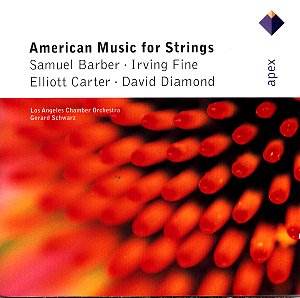Apart from the Irving Fine, all the works on this disc
are early products of their composers. The Barber Serenade is his opus
1, and was written in his late teens, probably 1928 or 1929. Its first
two movements, though expressive and well written, are probably too
similar in character. The finale, however, with its angular little dance
theme, is accomplished and memorable. This is an unassuming but attractive
work.
The Fine Serious Song of 1955, written for the
Louisville Orchestra, is an impressive piece, which builds up considerable
emotional tension and intensity, while the Carter is an arrangement
of a piece written when in his early 30s. It started out as a work for
'cello and piano, and Carter reworked it for string orchestra around
1952. It contains some really wonderful textures, taking the various
sections into extreme registers, but always playable and idiomatic.
The Diamond Rounds is probably the most developed
and musically satisfying work on the disc. Again, it is quite an early
work, dating from 1944 when Diamond was in his late 20s, and it reflects
various influences. The lively first movement has suggestions of the
springy rhythms found in Walton (Portsmouth Point) or even more
the Tippett of the Concerto for Double String Orchestra. The
Adagio makes much play with hanging soft-centred dissonances
in high and low strings, opening out into an expressive melodic line,
again alternating high and low strings. The finale uses the percussive
pizzicato beloved of Bartók, double-basses making the strings
snap against the fingerboard. Through all this, though, Diamond’s own
voice sounds strongly and convincingly.
The Los Angeles Strings under Paul Shure play with
great assurance and excellent tone and ensemble. The recording isn’t
particularly kind, sounding a little boxy and very ‘studio’. The slower
pieces in particular are not helped by this.
Request to apex. Please could recording details – date
and venue, total length etc.- be printed larger. The tiny type-face
strains my poor eye-sight to the limits!
Gwyn Parry-Jones


